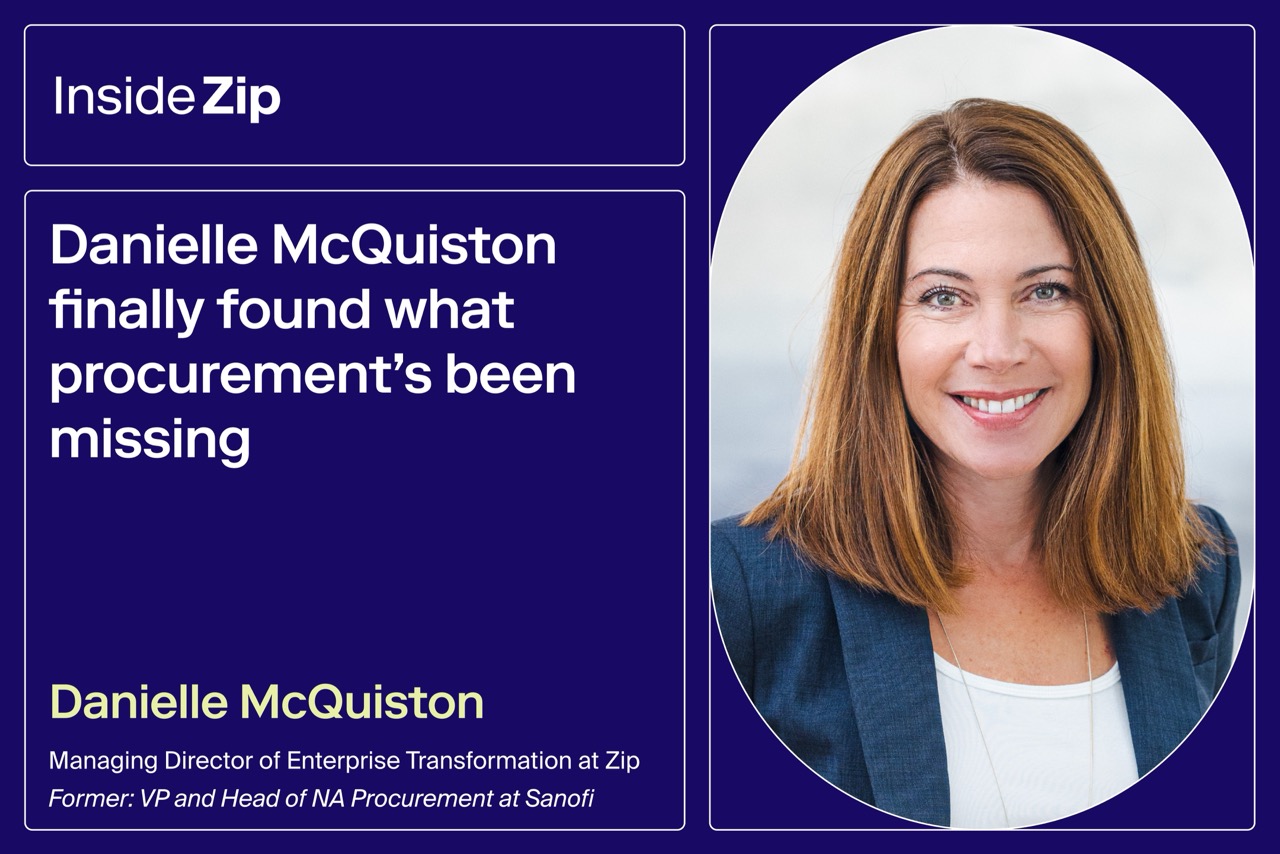
Approval workflow: How to create one and their benefits
Create an approval workflow that streamlines project management today.

The procurement process is a multi-layered, multi-stakeholder process that requires attention, oversight, and—of course—approvals. The reason so many employees are often left wondering ‘where’s my stuff!’ can be a result of the approval process lasting longer than they were preparing for.
For some purchases, a long-process is expected—for multi-million dollar purchases, or software that requires deep IT architecture or security reviews, cycle times can take weeks or even months. But often, a longer-than-expected approval flow may be a result of a poorly designed workflow.
In this article, we’ll take a look at how to create an effective approval workflow, the significance of each step, and how software like Zip is pioneering solutions for procurement finance leaders across all purchasing workflows.
What is an approval workflow?
An approval workflow is a structured sequence of steps designed to systematically process tasks or data within an organization. It necessitates obtaining approval at each stage before moving on, thus ensuring compliance and quality control.
However, without careful management, this process can introduce bottlenecks, delaying project timelines and impacting productivity. Let’s take a look at a step-by-step process to create an approval workflow that works.
For more into how automation and approval workflows integrate into a holistic procurement strategy that works, download our free book ‘The Executive Guide to Procurement Orchestration’.
How to create an approval workflow
Crafting an approval workflow that efficiently meets your organizational needs involves several important steps, each contributing to a smooth execution of tasks and decision-making processes.
Here are the steps to take:
1. Identify approval process needs
Pinpoint the specific areas within your business processes that require approvals. Understanding these needs is foundational in creating a workflow that eliminates bottlenecks and streamlines tasks.
2. Research and select an approval workflow software
Selecting the right software is pivotal. Your choice should not only meet your company’s approval process needs but also offer the functionality to automate and streamline these processes. Look for features such as template creation, document approval, and notifications to ensure a comprehensive solution.
Zip helps speed up stakeholder workflows and processes through a holistic procurement orchestration platform that starts at Intake—with a ‘single front door’ for requests that employees love to use, all necessary information is compiled and organized making approvals workflows a breeze.
3. Determine What Will Begin an Approval Process
Define the triggers that initiate an approval process. This could be the submission of a purchase order, project proposal, or invoice approval request, ensuring that the workflow begins with a clear action.
4. Define the Workflow
Map out the approval steps, including the routing paths for different types of approval requests. Try using workflow templates to standardize this process across various business functions, enhancing clarity and efficiency.
5. Implement the Software
With the software selected, it’s time to configure it to your business’s unique requirements. You might want to set up notifications, permission levels, and integrate with other tools such as SharePoint, Microsoft Teams, or Slack for seamless communication.
Zip makes this a breeze with Integration Platform, an easy way to sync processes across teams, allowing stakeholders to work within the tools they already use.
6. Onboard Relevant Employees
Ensure that team members are well-versed in using the new approval workflow software. Providing a tutorial or training session can facilitate a smooth transition to the new system, enabling real-time tracking of approval status, due dates, and automated workflows.
Incorporating these steps into your strategy can save time and resources, automate business processes, and eliminate the time-consuming manual approval actions.
Focusing on creating a streamlined approval workflow can help organizations avoid miscommunications and delays, and instead foster a culture of efficiency and continuous improvement.
Main components of an automated approval workflow
The transformation from manual to automated approval workflows involves integrating several key components that work together to streamline processes and eliminate bottlenecks. Be sure to consider these components to most effectively enhance approval procedures.
- Submission platform: The foundation of an efficient approval workflow is a robust platform where employees can submit invoices, documents, or purchase orders. This platform should be accessible and user-friendly, ensuring that all approval requests are logged and managed efficiently.
- Established permission levels: It’s vital to define who has the authority to approve what. By setting clear permission levels, organizations can automate the routing of approval requests to the appropriate stakeholders, saving time and reducing the risk of human error.
- Defined approvers for corresponding tasks: Each type of request should have designated approvers. This clarity prevents confusion and ensures that approval actions are taken by those with the right expertise and authority, further streamlining the approval process.
- Transparent approval updates and notifications: Automated notifications and real-time updates keep all stakeholders informed about the approval status, due dates, and any required actions. This transparency is key to maintaining the momentum of project management and business processes.
- Integrated process orchestration: Seamlessly connecting different software systems, like SharePoint for document management, Microsoft Teams for communication, or Slack for quick updates, enables a cohesive workflow. This integration ensures that the approval process is part of a larger, orchestrated effort to streamline operations.
- One platform for employee collaboration: A central platform where team members can collaborate, share feedback, and make decisions in context eliminates the need for disjointed email chains and fosters a culture of efficiency and teamwork.
With these core tenants considered to help manage your workflow automation, you’ll be able to avoid time-consuming manual tasks while also enhancing the overall functionality and efficiency of your approval workflow process.
Main roles in an approval workflow
The success of an approval workflow hinges on the clear definition of roles and responsibilities. Two primary roles play out and manage key parts of the process.
The Requester: The initiator of the process, the requester is responsible for submitting approval requests via the submission platform. Whether it’s a purchase order, project proposal, or invoice approval, the requester ensures that all necessary information and documents are included to facilitate a smooth approval process.
The Assessor: This role evaluates the submitted request. Assessors are often subject-matter experts or managers with the authority to approve or reject requests. They review the documentation for completeness, compliance, and accuracy before making an informed decision. The assessor’s role is crucial in maintaining the integrity and quality of the approval process.
Integrating these main components and roles into your automated approval workflow can transform how your organization handles approvals, making it more efficient, transparent, and scalable.
Why does the approval workflow matter?
An optimized, automated approval workflow is something any growing organization needs to adopt. This is not a luxury; it’s a necessity to ensure employees are able to get what they need to scale business efficiency. Without it, companies risk falling into the mire of outdated and over-stretched processes that can hamper productivity and growth.
Imagine a project that requires immediate sign-off on a purchase order. If the approval process is stuck in tedious communications, or is reliant on manual tracking, it can quickly become a bottleneck to business. This delay can stall the project and lead to missed opportunities and financial losses.
If a procurement team is waiting on final approval for a software update, they could be stuck using inefficient tooling, affecting the entire organization’s workflow management.
Automated approval workflow benefits
The transition to an automated approval workflow system offers many benefits, fundamentally changing how organizations handle approvals, AP automation, and internal process management. Here are some of the top benefits and use-cases of automated workflows.
Minimizing risk
By automating the approval workflow, businesses can enforce consistent application of policies and rules, significantly minimizing the risk associated with manual errors and oversight. Automate the pain away, as they say!
Reducing human error
Automation reduces the chances of errors that can occur with manual data entry or document handling, ensuring that every document approval workflow is accurate and reliable.
Speeding up approval cycle times
Automated workflows use ‘power-automate’ functionalities to expedite the approval process, ensuring that documents and requests move through the system swiftly, thus reducing wait times for approval actions.
Find out how Patreon was able to scale operations while improving vendor onboarding and contract management with Zip, reducing cycle times by 50% while also achieving an incredible 300% increase in spend under management.
Enhancing efficiency
By streamlining the approval process, employees can focus on their core tasks instead of getting bogged down by time-consuming administrative tasks, enhancing overall organizational efficiency.
Assigning ownership of approval permissions
Automation allows for clear assignment of approval permissions and responsibilities, ensuring that only authorized personnel can sign off on specific documents or requests, enhancing control and accountability.
Ensuring compliance
Automated approval workflows are designed to comply with regulatory requirements, making it easier for organizations to maintain compliance with industry standards and avoid penalties.
Cutting down costs
By reducing the need for manual processing and enabling quicker decision-making, automated approval workflows can significantly cut down operational costs.
Promoting transparent communication
With features such as real-time updates and mobile app notifications, stakeholders remain well-informed about the status of approval requests, promoting transparent and effective communication across the organization.
Automated approval workflows enable organizations to simplify and accelerate complex purchasing processes with greater agility and precision. From speeding up project timelines to ensuring final approval is granted efficiently and accurately, the advantages of moving away from traditional, manual approval processes are clear.
Now, let’s take a look at the top challenges in traditional processes that automation and procurement orchestration software can address head-on.
Top traditional approval workflow challenges
Traditional, or outdated approval workflows present several challenges that can significantly impede an organization’s efficiency and growth. Among the post pressing issues:
Confusing, tedious processes: Manual workflows often lack standardization, leading to confusing and lengthy procedures that can frustrate employees and delay decisions. A side effect of employees unhappy with a procurement process is rogue spend—when employees circumvent the process and go at it alone, creating as headable for accounting down the road.
Increased miscommunications: Reliance on emails and paper trails for approvals can result in lost requests, unclear instructions, and a general increase in miscommunications, complicating the approval process further.
Slow workflow times: The manual routing of documents and the need for physical signatures can drastically slow down the approval times, affecting the organization's ability to respond swiftly to market changes or internal requests.
Manual workflows not conducive to hybrid or remote work environments: With the rise of remote and hybrid work models, traditional approval workflows that rely heavily on physical presence and paper documents have become even more cumbersome, impacting productivity and flexibility.
Scale and grow with Zip’s automated approval workflows
In this guide, we’ve outlined the essential steps and components for creating an effective approval workflow, with a close consideration of the transformative power of automation. Automated workflows are a pathway to overcoming the limitations of traditional processes, and fundamentally transforming the way business can scale and improve efficiency.
Zip has pioneered approval automation as a part of a holistic procurement orchestration platform that can help scale a business of any size, offering solutions that can:
- Shorten cycle times: By ensuring visibility for all stakeholders and collecting necessary approval data upfront, Zip’s software eliminates bottlenecks and accelerates the approval process. Cross-functional reviews can occur in parallel, significantly reducing wait times.
- Scale for complexity: Zip’s intelligent routing ensures that approval requests are automatically directed to the appropriate individuals or subteams, based on predefined queues and user hierarchies. This dynamic selection process simplifies approvals, even in complex organizational structures.
- Collaborate in one place: With Zip, all approval tasks are centralized within a single interface, streamlining communication and decision-making. The need for back-and-forth emails is replaced with in-context commenting, and approvers can use integrated tools they are already familiar with, making the approval process more efficient and user-friendly—a process employees genuinely love to use.
In addressing traditional challenges head-on and providing a robust, scalable solution, Zip empowers organizations to embrace the new era of procurement. The benefits of moving to an automated approval workflow are clear: it reduces risk and increases efficiency, while also enhancing compliance and transparency across the board.
As your organization looks to innovate and streamline approval processes, consider the power of automation with Zip.
Ready to see how Zip can transform your approval workflows and help your business scale efficiently? Request a demo today and take the first step towards procurement perfection.

Maximize the ROI of your business spend

Enter your business email to keep reading



























.webp)




















.avif)













.avif)










.webp)





.avif)











.avif)
